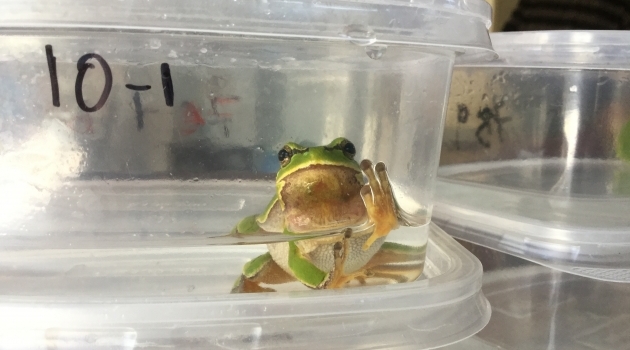Chernobyl’s frogs are thriving
How has the Chernobyl nuclear disaster affected wildlife? The zooologist German Orizaola was there in May to collect samples from tree frogs living in the Exclusion Zone, still abandoned by people after 30 years.
Chernobyl Exclusion Zone. Photo: German Orizaola
Why did you go to Chernobyl?
“Nuclear accidents, like in Chernobyl and Fukushima, have a huge impact on humans and on nature. But that acute impact lasts a few weeks or months and then radioactivity levels decrease dramatically. Still it is rather high, 20 or 100 times higher than here, but it hasn’t become a dead zone as it was expected. Already one or two years after the accident there were many animals in the zone, and they seemed fine. Now, 30 years on, it’s a paradise for animals, like wolves, dears, wild horses and amphibians. We want to understand what’s happening there.”
And why did you choose to study frogs?
“Amphibians are interesting because they live this double life, both in water and on land. And frogs don’t move that much, so you can almost connect an individual you have collected to a small area, and the precise radiation level of that area, either on land or in the sediment of a pond.”
Are you looking for genetic changes in the frogs?
“Yes, looking both for signs of adaption to living with radiation and for mutations that may affect them somehow. One of our hypotheses is that animals in Chernobyl may be living shorter lives, because they accumulate radiation and die earlier than animals in non-contaminated areas. But as long as they live long enough to reproduce, that is fine and should not be a big issue.”
What can we learn from this?
“Since no humans are there, there is no hunting, there are no pesticides and no agriculture. It’s quite sad to say, but it looks like the impact that humans can have on the environment is in some cases even bigger than a nuclear accident. Of course, not in the acute stage but on the mid–long term. It is the same in Fukushima in Japan, which was a smaller but more recent accident. We are also planning to go there and start tracking from early on what happens. Since Japan is limited in its space for humans there is also much more pressure for humans to go back in the area. Therefore, our research is important there.”
---Find out more:
Germán Orizaola is a researcher at the Department of Ecology and Genetics, Evolutionary Biology Centre. In May he went for a 10 day research trip to the Chernobyl Exclusion Zone, in Ukraine. During his stay there, he kept a “field diary” on his studies and movements in the exclusion zone.
Annica Hulth

